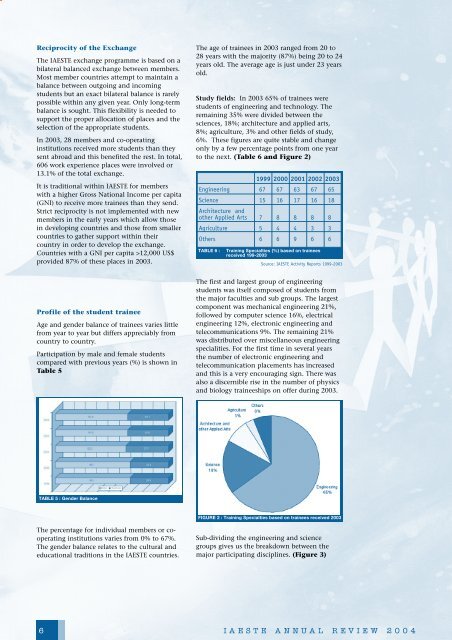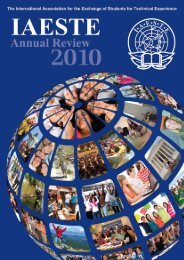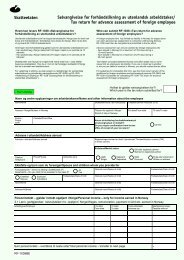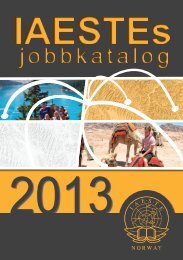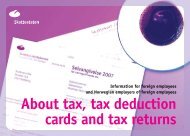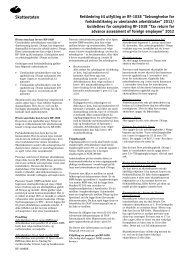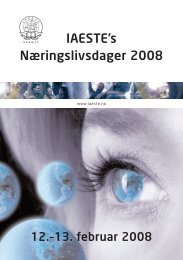View Annual Review - IAESTE
View Annual Review - IAESTE
View Annual Review - IAESTE
- No tags were found...
Create successful ePaper yourself
Turn your PDF publications into a flip-book with our unique Google optimized e-Paper software.
Reciprocity of the ExchangeThe <strong>IAESTE</strong> exchange programme is based on abilateral balanced exchange between members.Most member countries attempt to maintain abalance between outgoing and incomingstudents but an exact bilateral balance is rarelypossible within any given year. Only long-termbalance is sought. This flexibility is needed tosupport the proper allocation of places and theselection of the appropriate students.In 2003, 28 members and co-operatinginstitutions received more students than theysent abroad and this benefited the rest. In total,606 work experience places were involved or13.1% of the total exchange.It is traditional within <strong>IAESTE</strong> for memberswith a higher Gross National Income per capita(GNI) to receive more trainees than they send.Strict reciprocity is not implemented with newmembers in the early years which allow thosein developing countries and those from smallercountries to gather support within theircountry in order to develop the exchange.Countries with a GNI per capita >12,000 US$provided 87% of these places in 2003.The age of trainees in 2003 ranged from 20 to28 years with the majority (87%) being 20 to 24years old. The average age is just under 23 yearsold.Study fields: In 2003 65% of trainees werestudents of engineering and technology. Theremaining 35% were divided between thesciences, 18%; architecture and applied arts,8%; agriculture, 3% and other fields of study,6%. These figures are quite stable and changeonly by a few percentage points from one yearto the next. (Table 6 and Figure 2)1999 2000 2001 2002 2003Engineering 67 67 63 67 65Science 15 16 17 16 18Architecture andother Applied Arts 7 8 8 8 8Agriculture 5 4 4 3 3Others 6 6 9 6 6TABLE 6 :Training Specialties (%) based on traineesreceived 199-2003Source: <strong>IAESTE</strong> Activity Reports 1999-2003Profile of the student traineeAge and gender balance of trainees varies littlefrom year to year but differs appreciably fromcountry to country.Participation by male and female studentscompared with previous years (%) is shown inTable 5The first and largest group of engineeringstudents was itself composed of students fromthe major faculties and sub groups. The largestcomponent was mechanical engineering 21%,followed by computer science 16%, electricalengineering 12%, electronic engineering andtelecommunications 9%. The remaining 21%was distributed over miscellaneous engineeringspecialities. For the first time in several yearsthe number of electronic engineering andtelecommunication placements has increasedand this is a very encouraging sign. There wasalso a discernible rise in the number of physicsand biology traineeships on offer during 2003.TABLE 5 : Gender BalanceFIGURE 2 : Training Specialties based on trainees received 2003The percentage for individual members or cooperatinginstitutions varies from 0% to 67%.The gender balance relates to the cultural andeducational traditions in the <strong>IAESTE</strong> countries.Sub-dividing the engineering and sciencegroups gives us the breakdown between themajor participating disciplines. (Figure 3)6 I A E S T E A N N U A L R E V I E W 2 0 0 4


